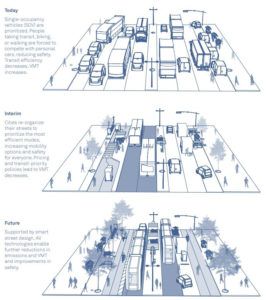The National Association of City Transportation Officials (NACTO) has released the second edition of its ‘Blueprint for Autonomous Urbanism’, focusing on the near-term policies and decisions that are necessary for autonomous vehicle (AV) technologies to improve transportation in cities worldwide.
Developed with a steering committee from NACTO’s 81 member cities and transit agencies, and based on the sweeping vision for city streets of the future in the first edition of the Blueprint, the second edition details the concrete steps that will need to be taken to ensure an equitable, people-first city, rather than lead to an overall increase in driving, greenhouse gas emissions, and diminished public spaces. Supported by Bloomberg Philanthropies and ClimateWorks Foundation, the second edition of the Blueprint also builds on the street designs envisioned in the first edition, outlining designs, policies, and tools to enable safe, frequent crossings, more sustainable and efficient use of the street, and a more vibrant pedestrian realm. It also includes more detailed sections on the actions that individual city departments, from IT to fleet services to parking authorities to employment and administrative services, should take to prepare as automated technology becomes more mature.

Key policies areas in the report include:
- Transit – Cities should commit to prioritizing high-quality on-street transit, and use technologies available today, such as computer-aided dispatch (CAD) and automatic vehicle location (AVL) systems, to improve efficiency and create services that attract riders. Future automated technologies, already in use in many rail systems, can enable transit agencies to expand services for more people at the same operating cost;
- Pricing – AVs could make driving easier and cheaper than it is today. Increased mobility will provide multiple benefits, but absent policy mechanisms and incentives to encourage people to use the most efficient modes, will see traffic and pollution continue to increase. Congestion pricing today, paired with new technologies that could allow governments to gauge traffic in real-time and accurately price travel demand, is crucial to influencing travel behavior;
- Data – As an increasing amount of information is collected in the public realm, ensuring that data is appropriately collected and protected by cities and companies alike is an increasingly urgent concern. With a coordinated approach to enhancing asset data, using open data specifications, and updating data management policies, public agencies can ensure access to crucial planning data while strengthening privacy protections for individuals;
- Urban Freight – Cities must develop sophisticated urban freight policies that group deliveries to reduce the number of freight trips and increase efficiency and safety. While AVs could make long-distance freight movement much more efficient, these technologies could also be detrimental within cities, flooding streets, sidewalks, and airspace with bots and drones. Downsizing vehicles, managing the curb, and keeping human workers for the last part of deliveries will be essential to managing the increasing volumes of goods movement within cities.
“When the automotive age swept the nation a century ago, cities responded not by adapting cars and trucks to the varied uses of the street, but with a relentless clearcutting of obstacles from curb to curb,” said Janette Sadik-Khan, NACTO chair and principal at Bloomberg Associates. “As we anticipate the arrival of self-driving vehicles on city streets today, we have a historic opportunity to correct these mistakes, which starts with a new blueprint for cities.”





